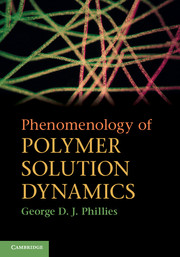Book contents
- Frontmatter
- Contents
- Preface
- 1 Introduction
- 2 Sedimentation
- 3 Electrophoresis
- 4 Quasielastic light scattering and diffusion
- 5 Solvent and small-molecule motion
- 6 Segmental diffusion
- 7 Dielectric relaxation and chain dimensions
- 8 Self- and tracer diffusion
- 9 Probe diffusion
- 10 Dynamics of colloids
- 11 The dynamic structure factor
- 12 Viscosity
- 13 Viscoelasticity
- 14 Nonlinear viscoelastic phenomena
- 15 Qualitative summary
- 16 Phenomenology
- 17 Afterword: hydrodynamic scaling model for polymer dynamics
- Index
- References
4 - Quasielastic light scattering and diffusion
Published online by Cambridge University Press: 05 August 2012
- Frontmatter
- Contents
- Preface
- 1 Introduction
- 2 Sedimentation
- 3 Electrophoresis
- 4 Quasielastic light scattering and diffusion
- 5 Solvent and small-molecule motion
- 6 Segmental diffusion
- 7 Dielectric relaxation and chain dimensions
- 8 Self- and tracer diffusion
- 9 Probe diffusion
- 10 Dynamics of colloids
- 11 The dynamic structure factor
- 12 Viscosity
- 13 Viscoelasticity
- 14 Nonlinear viscoelastic phenomena
- 15 Qualitative summary
- 16 Phenomenology
- 17 Afterword: hydrodynamic scaling model for polymer dynamics
- Index
- References
Summary
Introduction
For the most part, this volume does not discuss experimental methods. Other works provide sound descriptions of techniques and theoretical principles. How-ever, light scattering spectroscopy gave the earliest phenomenological findings that led me to writing this book. Also, the method was the basis of my career's experimental work. Here we consider optical techniques, and the correlation functions and diffusion coefficients that they determine. The emphasis is on understanding the physical quantities that are measured by light scattering spectrometers and related instruments. Actual measurements on complex fiuids appear in later chapters.
Quasielastic light scattering spectroscopy (QELSS) is an optical technique for observing transient local fiuctuations in the concentration and orientation of molecules in a liquid(1). Inelastic neutron scattering is sensitive to the same fluctuations. The wavelengths and time scales to which light and neutron scattering are sensitive are quite different, but a single theoretical picture describes the physical quantities observed by the two methods. Related optical techniques, notably Fluorescence RecoveryAfter Photobleaching (FRAP), Forced Rayleigh Scattering (FRS), Fluorescence Correlation Spectroscopy (FCS), and Depolarized Dynamic Light Scattering (DDLS) each give somewhat different information about molecularmotions. QELSS is also called Dynamic Light Scattering, “dynamic” in contrast to the “static” of “Static Light Scattering,” in which the experimenter determines the average intensity of the scattered light.
We first consider howlight scattering spectra are related to positions and motions of the dissolved scattering centers. We then present a nomenclature for diffusion coefficients. At least three paths have been used to calculate light scattering spectra of macromolecule solutions; each is described below.
- Type
- Chapter
- Information
- Phenomenology of Polymer Solution Dynamics , pp. 69 - 93Publisher: Cambridge University PressPrint publication year: 2011



